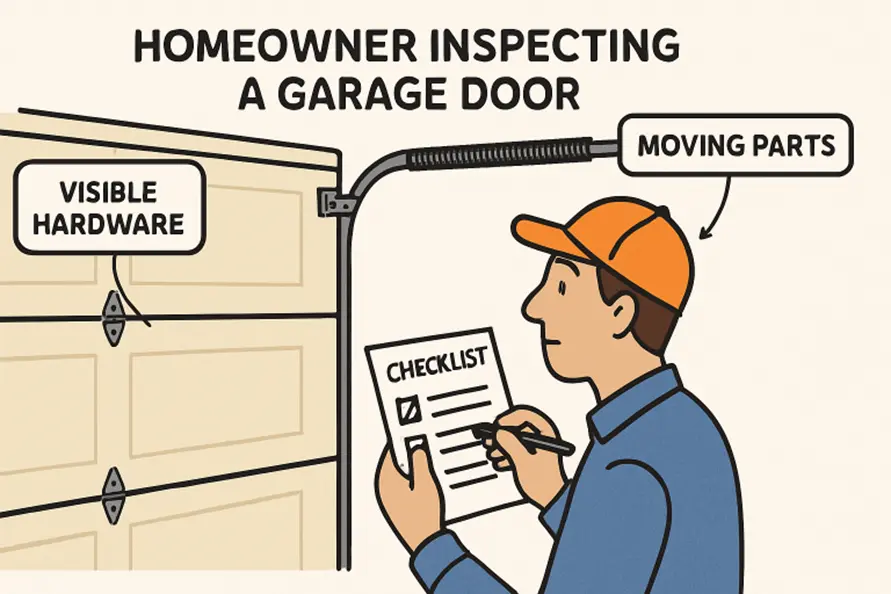Introduction
Garage doors play a vital role in any home, offering security, convenience, and safety. Yet, these mechanical systems are frequently overlooked until something goes wrong. Regular garage door maintenance & repair can prevent a range of avoidable problems, saving homeowners from expensive fixes and dangerous situations.
Ignoring routine care can lead to issues like doors getting stuck, not closing properly, or making loud noises. Regular preventive steps help ensure your garage door stays reliable. Environmental factors, such as humidity and seasonal changes, also impact performance, so regular maintenance helps prevent breakdowns. Understanding basic upkeep and when to call professionals extends your door’s lifespan and protects your home. For serious problems, hiring a repair service ensures safe and efficient repairs, as well as peace of mind.
Regular Inspection and Maintenance
Monthly inspections are crucial for identifying problems early, enabling you to avoid both inconvenience and potential injury. Start by visually examining cables for fraying, springs for rust or wear, and hardware for loose bolts and brackets. Listen for unusual sounds while the door operates—squeaks, grinding, or clatter often indicate a need for adjustment, lubrication, or garage door repair. According to Family Handyman, regular visual inspection and tightening of visible hardware can extend door life and prevent expensive emergencies.
Clean moving parts and look for signs of wear, paying special attention to rollers and hinges. If you spot worn or deteriorated parts, consider replacing them promptly. Develop a checklist to make inspections routine, so that maintenance tasks, such as tightening bolts or replacing weatherstrips, never get forgotten.
Lubrication of Moving Parts
A well-lubricated garage door moves smoothly and quietly. Lubricating the rollers, hinges, tracks, and springs every six months significantly reduces friction and prevents metal fatigue. Use a silicon-based lubricant or a garage door-specific spray—avoid heavy grease, as it can attract dust and debris. As recommended by Better Homes & Gardens, careful lubrication not only extends the life of moving parts but also prevents annoying noises and undue strain on the garage door opener.
During lubrication, operate the garage door up and down to distribute the product evenly and check for smooth movement. If you encounter stiff or jammed components despite lubrication, further inspection or replacement may be necessary.
Testing Safety Features
All modern garage doors feature safety mechanisms, most notably the auto-reverse sensor. Test this feature monthly by placing an object in the door’s path as it closes. The door should automatically reverse if the sensors are functioning. Dirty lenses, misaligned sensors, or faulty wiring can compromise sensor performance and must be addressed immediately for safety. Parents and pet owners should be particularly vigilant, as malfunctioning sensors pose significant risks to both pets and their owners.
Photo-Eye Alignment
Check that the photo-eyes (small plastic units mounted a few inches off the ground on each side of the door) are pointing directly at one another, and that no dirt or debris blocks their view. Misaligned or blocked safety sensors can lead to a malfunctioning auto-reverse mechanism, posing a safety hazard to family members and pets.
Addressing Worn or Broken Springs
Springs are among the most critical components of any garage door system, as they are responsible for lifting the door’s weight. Torsion and extension springs wear out over time—usually after 10,000 opening and closing cycles. You may notice a sudden inability to open the door or hear a loud bang when a spring breaks. Due to the high tension involved, spring replacement should only be performed by qualified technicians who have the right tools and expertise to do the job safely.
Warning Signs of Spring Failure
Besides an obviously snapped spring, look for a door that closes too quickly, opens haltingly, or appears crooked. Regular professional inspections can identify worn springs before they fail, avoiding situations where the door becomes stuck in either position.
Ensuring Proper Balance
A balanced garage door is essential for both smooth operation and mechanical longevity. An unbalanced door often stresses the opener, causing premature failure. To test the balance, disengage the opener by pulling the release handle and manually lift the door halfway. If it stays in place, the balance is good. If it falls or rises, you likely have a tension problem—an issue best resolved by a professional to prevent further damage or injury.
Hidden Costs of Imbalance
Operating a poorly balanced door can burn out your opener or cause additional parts to wear prematurely, leading to avoidable repair bills and unnecessary downtime.
Keeping Tracks Clear
The tracks that guide your garage door play a pivotal role in its smooth operation. Debris, dirt, or misalignment can cause the door to bind, stick, or even derail. Regularly examine tracks for signs of buildup and gently remove anything that might obstruct movement. In areas with high humidity, metal tracks can even expand or warp, necessitating realignment or replacement. Keeping tracks clean and aligned ensures your garage door runs quietly, saves wear on other parts, and prevents complete system failure down the road.
Conclusion
Preventing common garage door problems is all about diligence, routine care, and early detection. By inspecting, lubricating, testing, and cleaning your garage door system regularly, you proactively prevent more significant, costly issues and ensure safe operation for your family. When you do notice signs of trouble beyond DIY fixes, don’t hesitate to call professionals who specialize in garage door maintenance and repair. Consistency and prompt attention ensure that your garage door remains an asset, not a source of stress, in your everyday life.
Also Read-Selling a Home Made Simple: Tips & Tricks


